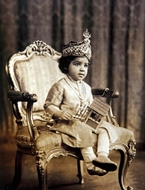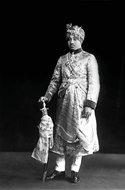![]() The Jodhpur Auction II
The Jodhpur Auction II
![]() The Jodhpur Auction II
VANDYK, LONDON
The Jodhpur Auction II
VANDYK, LONDON
RELATED LOTS
CONTACT US
Catalogue & Viewing
Lot Closed
Accounts & Shipping
Lot Closed
-
Details
 Details
Details
Umaid Bhawan Palace
The Umaid Bhawan Palace at Jodhpur, India's last great Palace, was constructed between 1929 and 1944. The Palace was originally
envisaged as a drought relief measure and the intention was to provide employment to over 3000 people afflicted by consecutive years
of drought, Constructed in what can loosely be described as the Indo-Art-Deco style, this magnificent edifice with 347 rooms was the
world's largest private residence when it opened its doors as a royal residence in 1944. Named after The Late His Highness Maharaja
Umaid Singhji, the palace has been the residence of Maharaja Umaid Singhji and his successors.
In fact, even today a section of the Palace is still the private residence of the royal family of Jodhpur, currently headed by His Highness
Maharaja Gaj Singh II. Converted to a hotel in 1972, the Palace was thrown open to the public at large as a residential hotel. Since
1978, the hotel has been associated with one of India's premier hotel chains-ITC Hotels. Today it the flagship of the welcome Heritage
Chain, which runs charming heritage hotels spread across Rajasthan and its adjoining states.
Guests and residents of the Palace experience aspects of royal living, with period furniture, priceless antiques and artefacts adorning
the public areas as well as the rooms in which the hotel section is situated Classified as a 5 Star Deluxe property by the Government of
India, the Umaid Bhawan Palace has every modern convenience to cater to today's traveller and several unique features.
The Central Dome soars 110 feet overhead, and provides spectacular centerpiece - a focal point for all the visitors to the property .The
Trophy Bar, the Risala Restaurant, the Marwar Hall, the Pillars restaurant and the Kebab Konner from the backbone of the hotels Food
& Beverage activities, providing residents and guests a choice of dining options and cuisines.
The view from the Pillars, especially at sunset, are spectacular. Landscaped gardens adorn the exteriors of the building and the spacious
lawns at the rear of the Palace create an ambience which is at once serene, restful and yet spectacularly royal. Deep inn the heart of
the building, the Zodiac Swimming Pool is a cool blue retreat. Located indoors, it is in fact under the main plinth of the building, tucked
away in the basement, which makes it private an accessible only to residents of the hotel.
The private museum attached to the Palace contains a small but exquisite set of display section, exhibiting arms, furniture, antique
clocks and priceless China vases that formed a part the private collection of Maharajas of Jodhpur. The Umaid Bhawan Palace is
equipped to cater to all segments of travelers, be they visitors on business or leisure to the city of Jodhpur.
The Palace has in the past few years become increasingly popular as a conference destination and venue with meeting spaces available
for small and large numbers contained within the building. A visit to Jodhpur cannot be complete without the experience of staying at
the Umaid Bhawan Palace, which is rated as perhaps the world's finest palace hotel.
16 17
-
Literature
 Literature
Literature

H. H. Maharaja Umaid Singh 1903 – 1947
Umaid Singh (8 July 1903 – 9 June 1947) was Maharaja of Jodhpur from 1918 to his death. The second son of Maharaja Sir Sardar Singh, he succeeded his elder brother Maharaja Sir Sumair Singh upon his death in 1918; in 1922 he served as the ADC to the Prince of Wales (later Edward VIII).
On 27th January,1923, in a Durbar in Jodhpur, the Viceroy, Lord Reading, invested Maharaja Umaid Singh with full ruling powers. It was a simple ceremony which consisted of the Viceroy presenting a sword to the twenty-year-old Maharaja but it reflected, none the less, the paramount power's vice like grip on the Rathores. Unlike his predecessors, however, Umaid Singh would not care to loosen this grip. Nor would he pretend it did not exist and retreat to a life of pleasure. He would rather, with admirable maturity and flair, use the British and draw on all they had to offer.
In 1923 he inherited a progressive kingdom with an efficient administration. In 1947 he bequeathed to India a model state with the beginnings of a representative government. Indeed, even Sardar Patel's States Ministry had to grudgingly admit that Jodhpur State was "viable" and could continue to exist as a separate, distinct administrative region in modern India. (Eighteen such "viable" Princely States were identified in all.) Perhaps the most benevolent of Marwar's Rathore rulers Umaid Singh was certainly her greatest builder and is justly remembered as the father of modern Marwar
There is about Maharaja Umaid Singh something uniquely exciting, an extravagance of vision, a power not only to dream but even to realize; in many ways, albeit on a smaller scale, not unlike that of the Mughals. He enjoyed polo so he took his own team to England with an army of ponies and Jodhpur emerged a world polo power. He loved flying so the Jodhpur Aerodrome became an international airport before Delhi with three trans-continental airlines stopping here. His decision to dabble in Bombay's fledgling stock market resulted, within a year, in his cornering the shares of the Tata Iron and Steel Company (TISCO), India's first heavy industry. And his famine relief policy, which shames many a modern day development project, changed the very face of Marwar, giving rise to one of the largest and most magnificent royal residences in the world and a dam that remains, half a century later, one of Jodhpur's main sources of drinking water.
Yet there was in him an astonishing simplicity, a grace he was born with and carried always, whether playing polo at Hurlingham or big-game hunting in Africa, salmon-fishing in Scotland or fox hunting at his sumptuous estate Arranmore in Ootacamund (south India). "He would wish people with both hands even if they waved with one", remembered the late Anthony Lobo, many, many years ago a larder boy in the Raika Bagh kitchens. Feted in the most fashionable of salons the world over he was, as Chief Scout of the Marwar State Scouts Association, equally at home in a boy scout's tent on the dusty grounds of his palace! It was this simplicity and humility, together with his stature and style that earned for the thirty-sixth Rathore ruler of Marwar the nickname Monarch. And it was always used with affection and respect...
Enjoying a distinguished military career, he died at his estate on Mount Abu on 9 June 1947 after a reign of 29 years, aged but 43.



